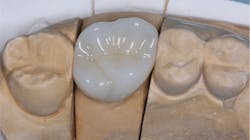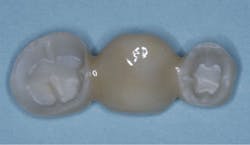How to reduce recurrent caries and crowns coming off
Q: I have been practicing for many years with an emphasis on restorative dentistry. During that time, I have placed thousands of crowns. In past years, zinc phosphate cement was the primary cement that everybody used, including myself. When accustomed to the proper mixing, zinc phosphate cement worked well with only a few negative characteristics. The most significant one was occasional postoperative tooth sensitivity that persisted for weeks to months. Crowns rarely came off in service and recurrent caries was infrequent. The next generation of cement, glass ionomer, also had infrequent but often unpredictable severe postoperative tooth sensitivity, but the cement retained crowns well. I have now replaced some of the glass ionomer cemented porcelain-fused-to-metal (PFM) or cast-gold alloy crowns placed during the 1970s, due to wear or porcelain fracture, and I have yet to see any severe caries on the teeth.
Zirconia crowns in dentistry: Uses, clinical challenges, and solutions
My question is this: why are we now plagued with crowns coming off and frequent areas of recurrent caries when using the current generation of resin cements? It appears we have gone backward with the newer cements.
Related reading:
A: Yes, anyone practicing during the last few years and placing zirconia crowns has observed the same challenges you stated. In some ways, the profession has gone backward with cements. However, there have also been some advancements. Examples such as triturating and self-mixing dispensing activation of cements have increased the predictability and homogeneity of dental cements. Nevertheless, your observations are correct. Zirconia crowns are frequently coming off, and this is apparently associated with current dental cements compared to previous cements. This challenge is important and frustrating, and it can be embarrassing for dentists and problematic for patients. I agree; the two challenges are: zirconia crowns coming off in service and caries on crown margins. But these issues are not going away and seem to be occurring more frequently (figure 1).
In this article, I will share potential methods to reduce the obvious problems that occur in using the current cements as well as potentially changing the cement being used.
Zirconia crowns coming off in service
There are several readily apparent reasons why zirconia crowns are coming off. The following information describes these reasons and provides potential solutions for the problems.
Tooth preparations are not retentive. A visit to your local dental lab will offer evidence for this statement. It is not a new problem. Despite the long-present need for more retentive crown preps, the crowns cemented historically with either zinc phosphate or conventional glass ionomer almost never came off in service. Several reasons for this challenge are:
- Often crown preparations are made on teeth that have already had restorative failures, and the remaining tooth structure is inadequate to retain the crowns.
- Retention-producing buildups have not been placed on the minimal amount of tooth remaining.
- Tooth preps are too short, such as crowns on mandibular second molars. An adequate crown prep is described many places in the literature as requiring 4 mm or more of axial walls from the gingival margin to the occlusal table.
- Tooth preps are too tapered. Optimum taper of the axial walls is well known to be no more than 20 degrees from parallel.
Dentists can easily remedy these challenges by making tooth preparations that meet the research-supported characteristics for an acceptable tooth preparation, placing strong retentive buildups when one-half or more of the coronal tooth structure is missing. But will this solve the overall problem? No! There are other reasons for zirconia crowns coming off.
The intaglio (internal) surfaces of milled zirconia crowns are smooth and lack mechanical retention. How can this problem be overcome? Assuming the tooth preparation is potentially inadequate to provide optimum retention, the following procedure can solve this portion of the problem of crowns coming off. Grooves can be cut in the axial walls of short preps to augment the retention (figure 2).Bond of cement to zirconia is minimal. Although bonding materials such as MDP primers (10-methacryloyloxydecyl dihydrogen phosphate) are being used to provide minimal bond of resin cement to zirconia, this mild bond has been shown to decrease with time.1 (Example products are Z-Prime Plus from Bisco and most of the “universal” bonding agents that are available.) These “universal” bonding agents also contain silane, which slightly enhances the bond of resin to lithium disilicate. The slight bond to zirconia is helpful as an adjunctive retentive concept, but it should not be expected to retain the crown.
Bond of resin cement to tooth structure is minimal. Research in the TRAC (Technologies in Restoratives and Caries Research) Division of Clinicians Report Foundation has shown that the failure mode when zirconia crowns come off is usually at the resin-cement-to-tooth surface, not at the cement-to-zirconia interface.2 This shows the long-term lack of success for current dentin bonding. Don’t depend on bonding agents on dentin surfaces to hold the crown in place. Research shows that bond to dentin is minimal and transient.3
Why do crowns stay on enamel surfaces, such as ceramic veneers seated over phosphoric acid-etched enamel? Luting of the resin cement into the thousands of phosphoric acid-etched enamel irregularities and the thousands of hydrofluoric acid-etched ceramic veneer irregularities hold the veneer in place. Veneers held by bonding agents to dentin are well known to come off soon after placement.
Consider the cement type you are using. Research in the TRAC Division of Clinicians Report (CR)4 has concluded from in vivo study that the cement type used makes a difference in crowns coming off in service. The CR study compared zirconia crowns cemented with resin cement or resin-modified glass ionomer (RMGI). In a practice-based study, crowns cemented with the more rigid RMGI were retained better than those cemented with the more flexible resin cement. This finding is diametrically opposed to some of the company ads supporting resin cements for minimally retentive crown preps.
A CR survey recently showed that 72% of US dentists are using RMGI most of the time.5 What would cause RMGI to hold crowns on better than resin cement? One potential reason is that resin cements are flexible, while zirconia is obviously rigid. The resin cement’s flexibility could be the reason for its more frequent release of crowns in service. Conventional glass ionomer is rigid, and it is common knowledge that glass ionomer cements seldom release crowns in service. RMGI is about 80% glass ionomer and only 20% resin.
Roughen the tooth preparation on the seating appointment (figure 3).Recurrent caries on the margins of zirconia crowns
RMGI has cariostatic properties because of the fluoride release from the glass ionomer component. Resin cements do not have cariostatic properties; they shrink about 2%, producing a microscopic marginal opening that cannot be avoided.6 Although CR has long suggested use of RMGI cement for zirconia crowns, some dentists continue to use resin. I suggest that if you are placing zirconia crowns with resin cement that you prescribe use of 5,000 ppm fluoride-containing toothpaste daily (for example, PreviDent 5000 from Colgate). Fluoride in trays should be offered to high-caries-potential patients with resin-cemented zirconia crowns, but this practice has less acceptable patient compliance than 5,000 ppm toothpaste.
Summary
Zirconia crowns are currently the most commonly placed indirect restorations in dentistry, according to Glidewell Laboratories.7 Properly fabricated zirconia crowns are working very well; the crowns are not breaking. However, there is no question that many zirconia crowns are coming off in service, contrary to those restorations previously placed with the historic cements, zinc phosphate and glass ionomer. Much of the problem appears to be related to cement and cementing. Additionally, some dentists are complaining of caries beginning on the zirconia crown margins. I have included the challenges presented by the dominant esthetic crown type in the US (zirconia), as well as potential methods to reduce or potentially eliminate the problems.
Dental manufacturers should focus on research to assist in overcoming these common and frustrating problems.
Author’s note: The following educational materials from Practical Clinical Courses offer further resources on this topic:
One-hour videos:
- Cementing Restorations—Proven and Successful (Item #V1921)
- Strong, Comfortable, Esthetic Rehabilitations with Zirconia (Item #V1942)
Two-day hands-on courses in Utah:
- Restorative Dentistry 1: Restorative, Esthetic, Preventive with Dr. Gordon Christensen
- Restorative Dentistry 2: Fixed Prosthodontics with Dr. Gordon Christensen
For more information, visit pccdental.com or contact Practical Clinical Courses at (800) 223-6569.
Editor's note: This article appeared in the August 2022 print edition of Dental Economics magazine. Dentists in North America are eligible for a complimentary print subscription. Sign up here.
References
- de Souza G, Hennig D, Aggarwal A, Tam LE. The use of MDP-based materials for bonding to zirconia. J Prosthet Dent. 2014;112(4):895-902. doi:10.1016/j.prosdent.2014.01.016
- Unpublished data: Clinicians Report Foundation observational in vivo research relating to ongoing studies of hundreds of crowns cemented with resin cement.
- Universal bonding adhesives: CR puts them to the test. Clinicians Report. 2020;13(10).
- RMGI cement is #1: are you using it effectively? Clinicians Report. 2018;11(3).
- Cements 2022: concrete suggestions for every restoration. Clinicians Report. 2022;15(4).
- First look: the latest glass ionomer restoratives. Clinicians Report. 2020;13(1).
- Personal communication. Darryl Withrow, VP operations, Glidewell Laboratories.
About the Author

Gordon J. Christensen, DDS, PhD, MSD
Gordon J. Christensen, DDS, PhD, MSD, is founder and CEO of Practical Clinical Courses and cofounder of Clinicians Report. His wife, Rella Christensen, PhD, is the cofounder. PCC is an international dental continuing education organization founded in 1981. Dr. Christensen is a practicing prosthodontist in Provo, Utah.



